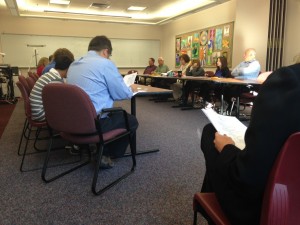Judging by her face, Southeastern Massachusetts Educational Collaborative (SMEC) Executive Director Catherine Cooper was bracing herself for disappointment.
For months, Cooper had been negotiating with the SMEC subcommittee to rent space at ORR for a special education program for three to eight students with significant developmental delays, including Autism, from other districts who are part of the collaborative.
The SMEC program at ORR would be based out of a substantially separate classroom, but the SpEd students would be gradually integrated into the general classroom setting at ORR.
ORR Principal Michael Devoll had concerns about what he called a difference in philosophy, implying the separated SpEd classroom program would clash with the school’s full-inclusion program for SpEd students.
“We do have the space,” said Devoll. However, he said the school prides itself on welcoming its SpEd students into the general classroom, and worried that a self-contained classroom would send mixed messages to students and staff at ORR.
“We do a great job with our students,” said Devoll. “And we believe it (full inclusion) works.”
School Committee members were unclear about the segregation aspect of the program and how Cooper envisioned the program would function at ORR.
Two parents in attendance spoke out against the separation aspect of the program, saying the full-inclusion program worked well for their kids, and one mother whose child graduated from ORR said she was against any model that included separation of the SpEd students from the general education setting.
The SMEC program would not be an entirely separate classroom program, but rather a partial-inclusion program that Cooper said is recommended by each of the students’ Individualized Education Programs (IEP), which is developed by the student’s IEP team that consists of the student’s parents, educators, and therapists.
Cooper said most of the would-be program’s students are non-verbal, and a full-inclusion setting would not be appropriate at the present time. She said the ultimate goal of the program is to gradually integrate the students into the general classroom, and then reintegrate the students into their home districts.
The students would be based in their own self-contained classroom, but attend a regular ORR class and gradually attend more if appropriate.
ORR’s culture of welcoming special needs students into the integrated setting is what drew Cooper to ORR, she said. Some other program sites were unsuccessful in other districts, she said, because the school’s culture was not welcoming of the special needs students and the administration of the school was not supportive of the program.
The phrase “difference in philosophy” came up several times.
Committee member Robin Rounseville said she did not think it was a different philosophy per se, because full integration was the main goal of the program. She acknowledged that, due to the severity of some of the needs of the students, they might need “a little longer to get there.”
Chairman James O’ Brien, who is on the SMEC subcommittee, asked after hearing some debate from Devoll and the two parents, “Are we truly a member of that collaborative, or are we choosing to be when we want to be?” He said the SMEC program would be the least restrictive setting – a concept that is mandated by the Individuals with Disabilities Education Act (IDEA).
“I’ve gone back and forth like five times,” said School Committee member Nick Decas. “I don’t know how I’m going to vote, honestly.” He said he was not sure if ORR was ready for the program and if staff were properly trained for the change.
Cooper stated that specific teachers would be approached before students were placed.
“We’ll know fairly quickly who will be great, who is willing, and who wants nothing to do with it,” said Cooper. But without the administration’s support, the program might not be successful.
“This is a chance to give these children a huge opportunity,” said committee member Michelle Oullette.
Student representative Renae Reints told the committee she did not think the program sounded too restrictive and separate, saying that perhaps the SMEC students just needed a little more separate program, but the students would welcome them. Decas later stated that Reints’ comment persuaded him to vote in favor.
The vote to accept the program was unanimous, with committee member Charles Motta “passing” on the vote because he was unsure.
Also during the meeting, committee members discussed school choice options for next year and based their decision primarily on class size. The junior high has the highest average class size in the district at 24.5 students.
There currently are 94 school choice slots at ORR – 72 at the high school and 12 at the junior high.
The board voted to continue to offer 72 slots at the high school, but will refrain from offering any slots at the junior high, at a loss of $60,000. The district receives $5,000 for each school choice student.
In other news, Devoll announced that this year’s graduation ceremony will begin at 12:00 pm, rather than the traditional 1:00 pm.
He said, for many years, some students have had to make some “hard decisions” over whether to attend graduation or miss out on other events, like track competitions.
In other matters, O’ Brien pointed out that this was the first ORR School Committee meeting to be held since the 2011 ORR cyber-theft incident was discussed at a joint meeting with the Tri-Town selectmen.
“In several instances, I rolled up my sleeves to support this committee,” said O’ Brien. He added that the committee members give up their time to work on behalf of the students, and he mentioned the criticism the School Committee has received from the Tri-Town selectmen over the committee’s handling of the incident.
“Enough!” said O’ Brien sternly. He commended the committee for “try[ing] to do what’s right for the kids.” He told the committee members to “stay strong” before adjourning the meeting.
The next ORR School Committee meeting will be June 11 at 6:00 pm in the superintendent’s conference room at ORR.
By Jean Perry
